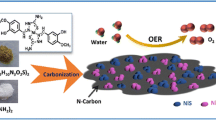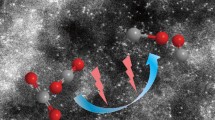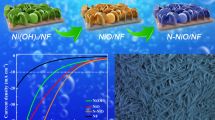Abstract
Among various chalcogenide materials, transition metal sulfides are known to be effective catalysts for the electrochemical hydrogen evolution reaction (HER). In particular, Ni-Co-S is a promising material for the next generation of non-precious metal HER catalysts due to its excellent HER activity in neutral pH solutions. Ni-Co-S is also advantageous in large-scale applications, as it enables relatively simple catalytic synthesis through electrodeposition. In this study, we employed a new S precursor, 2,5-dimercapto-1,3,4-thiadiazole (DMTD), for the electrodeposition of Ni-Co-S, instead of the conventional S precursor, thiourea (TU). Ni-Co-S synthesized with DMTD (Ni-Co-SDMTD) showed enhanced HER activity at neutral pH compared to that synthesized with TU (Ni-Co-STU). It has been found that this improvement in activity is due to the large surface area and high S content of Ni-Co-SDMTD. The S content and HER activity of Ni-Co-SDMTD depend on the concentration of DMTD. At the optimal DMTD concentration (12 mM), Ni-Co-SDMTD exhibited an overpotential of 303 mV at a current density of 10 mA cm− 2 and a Tafel slope of 99 mV dec− 1 in a phosphate buffer solution (pH 7.4).
Graphical Abstract







Similar content being viewed by others
Data Availability
The data presented in this study are available from the corresponding author upon reasonable request.
References
X. Zou, Y. Zhang, Noble metal-free hydrogen evolution catalysts for water splitting. Chem. Soc. Rev. 44, 5148–5180 (2015)
S. Dutta, A review on production, storage of hydrogen and its utilization as an energy resource. J. Ind. Eng. Chem. 20, 1148–1156 (2014)
G. Zhao, K. Rui, S.X. Dou, W. Sun, Heterostructures for electrochemical hydrogen evolution reaction: a review. Adv. Funct. Mater. 28, 1803291 (2018)
A.M. Abdalla et al., Hydrogen production, storage, transportation and key challenges with applications: a review. Energy. Conv. Manag. 165, 602–627 (2018)
X. Xu, P. Du, Z. Chen, M. Huang, An electrodeposited cobalt–selenide-based film as an efficient bifunctional electrocatalyst for full water splitting. J. Mater. Chem. A 4, 10933–10939 (2016)
G.B. Darband, M. Aliofkhazraei, S. Hyun, A.S. Rouhaghdam, S. Shanmugam, Electrodeposited NiCoP hierarchical nanostructure as a cost-effective and durable electrocatalyst with superior activity for bifunctional water splitting. J. Power Sources. 429, 156–167 (2019)
Y. Shi, B. Zhang, Recent advances in transition metal phosphide nanomaterials: synthesis and applications in hydrogen evolution reaction. Chem. Soc. Rev. 45, 1529–1541 (2016)
C.C. McCrory et al., Benchmarking hydrogen evolving reaction and oxygen evolving reaction electrocatalysts for solar water splitting devices. J. Am. Chem. Soc. 137, 4347–4357 (2015)
A.P. Murthy, J. Madhavan, K. Murugan, Recent advances in hydrogen evolution reaction catalysts on carbon/carbon-based supports in acid media. J. Power Sources. 398, 9–26 (2018)
P. Wang, K. Jiang, G. Wang, J. Yao, X. Huang, Phase and interface engineering of platinum–nickel nanowires for efficient electrochemical hydrogen evolution. Angew. Chem. 128, 13051–13055 (2016)
D.V. Esposito, S.T. Hunt, Y.C. Kimmel, J.G. Chen, A new class of electrocatalysts for hydrogen production from water electrolysis: metal monolayers supported on low-cost transition metal carbides. J. Am. Chem. Soc. 134, 3025–3033 (2012)
P.C. Vesborg, B. Seger, I. Chorkendorff, Recent development in hydrogen evolution reaction catalysts and their practical implementation. J. Phys. Chem. Lett. 6, 951–957 (2015)
W.-F. Chen, J.T. Muckerman, E. Fujita, Recent developments in transition metal carbides and nitrides as hydrogen evolution electrocatalysts. Chem. Commun. 49, 8896–8909 (2013)
S. Jing et al., N-doped porous molybdenum carbide nanobelts as efficient catalysts for hydrogen evolution reaction. Appl. Catal. B 224, 533–540 (2018)
W.F. Chen et al., Hydrogen-evolution catalysts based on non‐noble metal nickel–molybdenum nitride nanosheets. Angew. Chem. Int. Ed. 51, 6131–6135 (2012)
B. Cao, G.M. Veith, J.C. Neuefeind, R.R. Adzic, P.G. Khalifah, Mixed close-packed cobalt molybdenum nitrides as non-noble metal electrocatalysts for the hydrogen evolution reaction. J. Am. Chem. Soc. 135, 19186–19192 (2013)
M.Q. Wang, C. Ye, H. Liu, M. Xu, S.J. Bao, Nanosized metal phosphides embedded in nitrogen-doped porous carbon nanofibers for enhanced hydrogen evolution at all pH values. Angew. Chem. 130, 1981–1985 (2018)
H. Du, R.-M. Kong, X. Guo, F. Qu, J. Li, Recent progress in transition metal phosphides with enhanced electrocatalysis for hydrogen evolution. Nanoscale. 10, 21617–21624 (2018)
R. Miao et al., Mesoporous iron sulfide for highly efficient electrocatalytic hydrogen evolution. J. Am. Chem. Soc. 139, 13604–13607 (2017)
P. Kuang, T. Tong, K. Fan, J. Yu, In situ fabrication of Ni–Mo bimetal sulfide hybrid as an efficient electrocatalyst for hydrogen evolution over a wide pH range. ACS Catal. 7, 6179–6187 (2017)
A.P. Murthy, D. Govindarajan, J. Theerthagiri, J. Madhavan, K. Parasuraman, Metal-doped molybdenum nitride films for enhanced hydrogen evolution in near-neutral strongly buffered aerobic media. Electrochim. Acta. 283, 1525–1533 (2018)
Z. Zhou et al., Electrocatalytic hydrogen evolution under neutral pH conditions: current understandings, recent advances, and future prospects. Energy Environ. Sci. 13, 3185–3206 (2020)
X. Guo et al., Sulfur vacancy-tailored NiCo 2 S 4 nanosheet arrays for the hydrogen evolution reaction at all pH values. Catal. Sci. Technol. 10, 1056–1065 (2020)
A. Irshad, N. Munichandraiah, Electrodeposited nickel–cobalt–sulfide catalyst for the hydrogen evolution reaction. ACS Appl. Mater. Interfaces. 9, 19746–19755 (2017)
B. Liu et al., Nickel–cobalt diselenide 3D mesoporous nanosheet networks supported on ni foam: an all-pH highly efficient integrated electrocatalyst for hydrogen evolution. Adv. Mater. 29, 1606521 (2017)
J. Xu et al., Highly dispersive NiCo2S4 nanoparticles anchored on nitrogen-doped carbon nanofibers for efficient hydrogen evolution reaction. J. Colloid Interface Sci. 555, 294–303 (2019)
Z. Peng, D. Jia, A.M. Al-Enizi, A.A. Elzatahry, G. Zheng, From water oxidation to reduction: homologous Ni–Co based nanowires as complementary water splitting electrocatalysts. Adv. Energy Mater. 5, 1402031 (2015)
Q. Che et al., One-step electrodeposition of a hierarchically structured S-doped NiCo film as a highly-efficient electrocatalyst for the hydrogen evolution reaction. Nanoscale. 10, 15238–15248 (2018)
X. Ren et al., An amorphous FeMoS 4 nanorod array toward efficient hydrogen evolution electrocatalysis under neutral conditions. Chem. Commun. 53, 9000–9003 (2017)
C.-H. Lee et al., Insight into the superior activity of bridging sulfur-rich amorphous molybdenum sulfide for electrochemical hydrogen evolution reaction. Appl. Catal. B 258, 117995 (2019)
K. Du et al., Electrodeposited Mo3S13 films from (NH4) 2Mo3S13· 2H2O for electrocatalysis of hydrogen evolution reaction. ACS Appl. Mater. Interfaces. 9, 18675–18681 (2017)
L.R.L. Ting et al., Catalytic activities of sulfur atoms in amorphous molybdenum sulfide for the electrochemical hydrogen evolution reaction. ACS Catal. 6, 861–867 (2016)
M. Fan et al., An efficient nanostructured copper (I) sulfide-based hydrogen evolution electrocatalyst at neutral pH. Electrochim. Acta. 215, 366–373 (2016)
J. Wang, H.-. Zhong, Z.-. Wang, F.-. Meng, Zhang, X.-b. Integrated three-dimensional carbon paper/carbon tubes/cobalt-sulfide sheets as an efficient electrode for overall water splitting. ACS nano. 10, 2342–2348 (2016)
W. Chen, C. Xia, H.N. Alshareef, One-step electrodeposited nickel cobalt sulfide nanosheet arrays for high-performance asymmetric supercapacitors. ACS nano. 8, 9531–9541 (2014)
R.A. Marquez-Montes et al., Mass transport-enhanced electrodeposition of Ni–S–P–O films on nickel foam for electrochemical water splitting. J. Mater. Chem. A 9, 7736–7749 (2021)
J. Shi, X. Li, G. He, L. Zhang, M. Li, Electrodeposition of high-capacitance 3D CoS/graphene nanosheets on nickel foam for high-performance aqueous asymmetric supercapacitors. J. Mater. Chem. A 3, 20619–20626 (2015)
D. Merki, S. Fierro, H. Vrubel, X. Hu, Amorphous molybdenum sulfide films as catalysts for electrochemical hydrogen production in water. Chem. Sci. 2, 1262–1267 (2011)
D.W. Redman, M.J. Rose, K.J. Stevenson, Electrodeposition of amorphous molybdenum chalcogenides from ionic liquids and their activity for the hydrogen evolution reaction. Langmuir. 33, 9354–9360 (2017)
X. Li et al., Sequential electrodeposition of bifunctional catalytically active structures in MoO3/Ni–NiO composite electrocatalysts for selective hydrogen and oxygen evolution. Adv. Mater. 32, 2003414 (2020)
S. Wang et al., Facile electrodeposition of three-dimensional flower-like structure of nickel matrix composite electrodes for hydrogen evolution reaction. Appl. Surf. Sci. 498, 143768 (2019)
J. Hu et al., A crystalline–amorphous Ni–Ni (OH) 2 core–shell catalyst for the alkaline hydrogen evolution reaction. J. Mater. Chem. A 8, 23323–23329 (2020)
X. Zhao, X. Chen, Y. Wang, P. Song, Y. Zhang, High-efficiency Ni–P catalysts in amorphous and crystalline states for the hydrogen evolution reaction. Sustainable Energy & Fuels. 4, 4733–4742 (2020)
H. Huang et al., Structural design of amorphous CoMoPx with abundant active sites and synergistic catalysis effect for effective water splitting. Adv. Funct. Mater. 30, 2003889 (2020)
L. Gao et al., Crystalline cobalt/amorphous LaCoO x hybrid nanoparticles embedded in porous nitrogen-doped carbon as efficient electrocatalysts for hydrazine-assisted hydrogen production. ACS Appl. Mater. Interfaces. 12, 24701–24709 (2020)
S. Poorahong, R. Izquierdo, M. Siaj, An efficient porous molybdenum diselenide catalyst for electrochemical hydrogen generation. J. Mater. Chem. A 5, 20993–21001 (2017)
W. Dai et al., A novel Ni-S-Mn electrode with hierarchical morphology fabricated by gradient electrodeposition for hydrogen evolution reaction. Appl. Surf. Sci. 514, 145944 (2020)
S. Hou et al., Carbon-incorporated Janus-type Ni2P/Ni hollow spheres for high performance hybrid supercapacitors. J. Mater. Chem. A 5, 19054–19061 (2017)
C. Miao et al., Facile electrodeposition of amorphous nickel/nickel sulfide composite films for high-efficiency hydrogen evolution reaction. ACS Appl. Energy Mater. 4, 927–933 (2021)
T. Sun et al., Ordered mesoporous NiCo alloys for highly efficient electrocatalytic hydrogen evolution reaction. Int. J. Hydrog. Energy. 42, 6637–6645 (2017)
Y. Liu et al., Surface phosphorsulfurization of NiCo2O4 nanoneedles supported on carbon cloth with enhanced electrocatalytic activity for hydrogen evolution. Electrochim. Acta. 290, 339–346 (2018)
Q. Sun et al., Dual anions engineering on nickel cobalt-based catalyst for optimal hydrogen evolution electrocatalysis. J. Colloid Interface Sci. 589, 127–134 (2021)
D. Zha, Y. Fu, L. Zhang, J. Zhu, X. Wang, Design and fabrication of highly open nickel cobalt sulfide nanosheets on ni foam for asymmetric supercapacitors with high energy density and long cycle-life. J. Power Sources. 378, 31–39 (2018)
P. Juan et al., Sulfur-rich molybdenum sulfide grown on porous N-Doped graphene for efficient hydrogen evolution. Ind. Eng. Chem. Res. 59, 12862–12869 (2020)
B. Seo et al., Preferential horizontal growth of tungsten sulfide on carbon and insight into active sulfur sites for the hydrogen evolution reaction. Nanoscale. 10, 3838–3848 (2018)
B. Seo et al., Monomeric MoS42–-derived polymeric chains with active molecular units for efficient hydrogen evolution reaction. ACS Catal. 10, 652–662 (2019)
M. Dave et al., Understanding homogeneous hydrogen evolution reactivity and deactivation pathways of molecular molybdenum sulfide catalysts. Sustainable Energy & Fuels. 2, 1020–1026 (2018)
W. Xu et al., A highly efficient electrocatalyst based on amorphous Pd–Cu–S material for hydrogen evolution reaction. J. Mater. Chem. A 5, 18793–18800 (2017)
Funding
This research was supported by the Korea Institute of Science and Technology (No. 2E31871). This research was also supported by the National Research Foundation of Korea (NRF) grant funded by the Korean government (MSIT) (No. NRF-2022R1F1A1074205).
Author information
Authors and Affiliations
Contributions
Yeosol Yoon: conceptualization, methodology, investigation, data curation, and writing original draft; Sehyun Yoo: data curation, validation, and reviewing; Taeho Lim: conceptualization, resources, reviewing, editing, project administration, funding acquisition. All authors have approved the submission of the manuscript.
Corresponding author
Ethics declarations
Competing interests
The authors declare no competing interests.
Ethical Approval
Not applicable.
Additional information
Publisher’s Note
Springer Nature remains neutral with regard to jurisdictional claims in published maps and institutional affiliations.
Electronic Supplementary Material
Below is the link to the electronic supplementary material.
Rights and permissions
Springer Nature or its licensor (e.g. a society or other partner) holds exclusive rights to this article under a publishing agreement with the author(s) or other rightsholder(s); author self-archiving of the accepted manuscript version of this article is solely governed by the terms of such publishing agreement and applicable law.
About this article
Cite this article
Yoon, Y., Yoo, S. & Lim, T. Electrodeposition of Ni-Co-S Electrocatalyst Using 2,5-dimercapto-1,3,4-thiadiazole as S Precursor for Hydrogen Evolution Reaction at Neutral pH. Electrocatalysis 14, 800–809 (2023). https://doi.org/10.1007/s12678-023-00837-8
Accepted:
Published:
Issue Date:
DOI: https://doi.org/10.1007/s12678-023-00837-8




